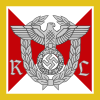
Back الرايخ سليتر Arabic Рэйхсляйтар Byelorussian Reichsleiter Catalan Reichsleiter Danish Struktur der NSDAP#Die Reichsleiter German Reichsleiter Spanish Reichsleiter French רייכסלייטר HE Reichsleiter ID Reichsleiter Italian
| Reichsleiter | |
|---|---|
 Flag 1939–1945 | |
  Pre and post 1939 insignia | |
 Armband | |
| Country | |
| Service branch | |
| Abbreviation | RL |
| Rank | Paramilitary rank |
| Formation | 2 June 1933 |
| Abolished | 8 May 1945 |
| Next higher rank | Führer |
| Next lower rank | Gauleiter |
Reichsleiter (German pronunciation: [ˈʁaɪ̯çsˌlaɪ̯tɐ] , transl. national leader or Reich leader) was the second-highest political rank in the Nazi Party (NSDAP), subordinate only to the office of Führer. Reichsleiter also functioned as a paramilitary rank within the NSDAP and was the highest rank attainable in any Nazi organisation.[1]
Each Reichsleiter reported directly to the Führer, Adolf Hitler. Men of the rank Reichsleiter collectively formed part of the Reichsleitung (Reich leadership) of the NSDAP, which was originally located in the "Brown House" in Munich. Each Reichsleiter was in charge of a broad area of responsibility in the party. Hitler originally established the rank of Reichsleiter on 2 June 1933 and appointed 16 individuals to that rank.[2] Subsequently, a further 6 individuals were appointed to the rank between 1933 and 1938: von Epp, Frick, Bormann, Lutze, Hierl and Huhnlein.[3]
- ^ "The Organization of the Nazi Party & State". nizkor.org. The Nizkor Project. Archived from the original on 9 November 2016. Retrieved 13 April 2016.
- ^ Dietrich Orlow: The Nazi Party 1919-1945: A Complete History, Enigma Books, New York, 2010, p. 263. ISBN 978-1-929631-57-5.
- ^ "Reichsleiters of the NSDAP" in Axis History Retrieved 27 June 2020.